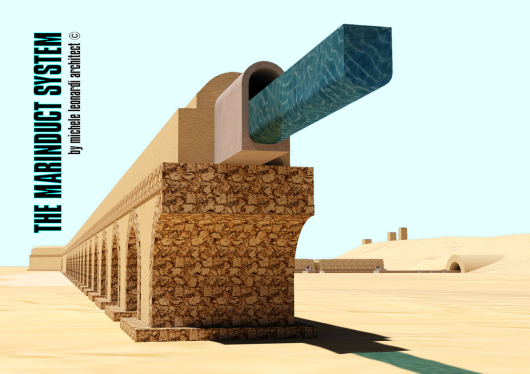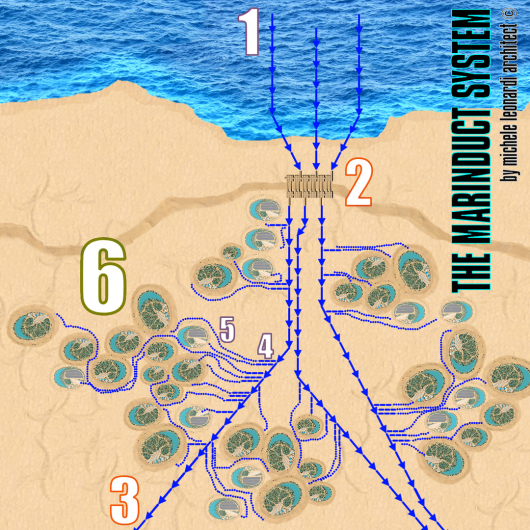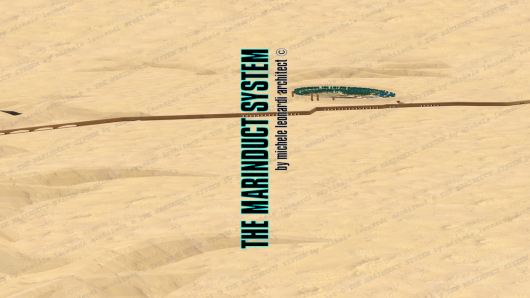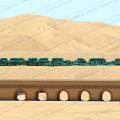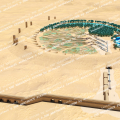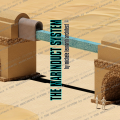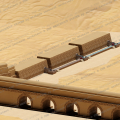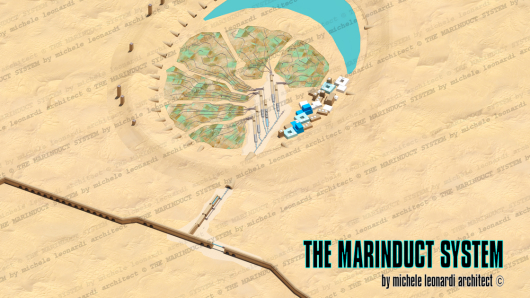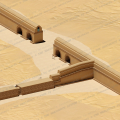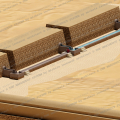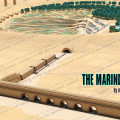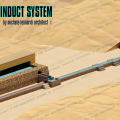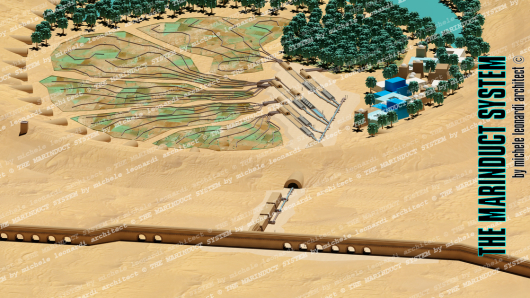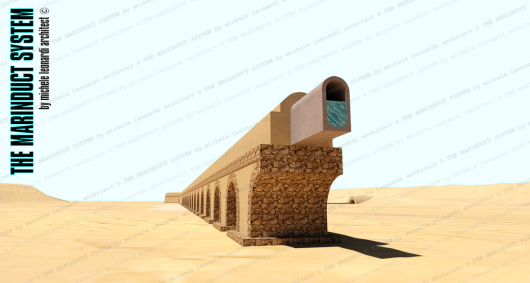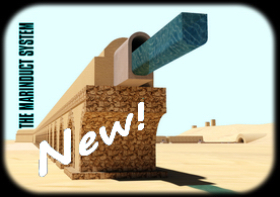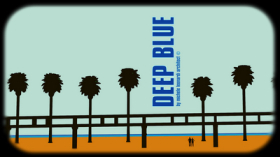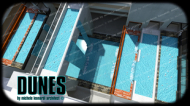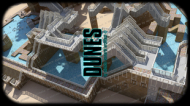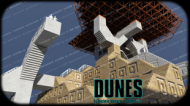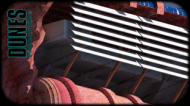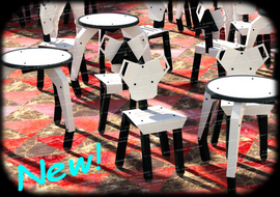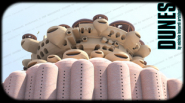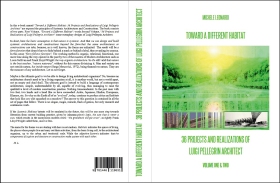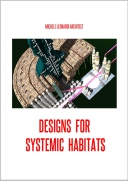The Marinduct
Oasis System
THE MARINE WATER AQUEDUCT AND OASIS SYSTEM
FOR NEW HABITATS IN THE DESERT
BY MEANS OF DECENTRALIZED DESALINATION UNITS
by Michele Leonardi architect © 1996, concept. July 2019, designs.
THE MARINDUCT:
The Marine Water Aqueduct and Oasis System for desertic areas of the world connected to the sea: Sahara, Arbian Peninsula, deserts of Persian Gulf, Iran, Pakistan, South India, Australia, Andean Pacific Coast, South California, Texas, etc.
WHAT'S THE NEWS?
1) Already at the beginning of the last century, in some European cities there were marine aqueducts used mainly for street cleaning.
2) In Hong Kong, the Hongkong & Shanghai Bank Building (Norman Foster and Partners architects; completed in 1985) is cooled with a sea water system for the air-conditioning. This skyscraper is linked to the bay by a 7-meter-diameter tunnel, 350 meters long, with a capacity of 1,250 liters of sea water per second.
3) In the Persian Gulf countries the sea water is taken from the sea, desalinated in the large plants, then the fresh water thus produced is transported, even at a great distance, up to the cultivations irrigated with "fossil" water, where finally the fresh water is introduced into the same aquifer to recharge it, as well as evidently to remineralize it.
4) It is not a mystery that the pools of many tourist resorts located by the sea and in desert areas, are fed with seawater.
SO WHAT
is the news? And where is the difference?
1) The news are the decentralized desalination units in the artificial oasis.
The Marinduct translates and distributes sea water, which is desalinated locally, in new oases to be built in the desert. So there is no a large centralized desalination plant and after fresh water distribution, but each local unit, each small or large community, desalinate its own quantity of sea water to be used.
2) The Marinduct is implemented over time as needed, by new lines addition (new parallel Marinducts), anyway gradually, functionally. There is no colossal initial spending of money to make this great work, in progress. In a second moment, wanting to increase the mass flow rate of Marinduct, it's also possible to foresee the duct duplication in height, vertically, with a second or even a third internal single duct per Marinduct.
3) Sea water does not need exceptional treatments to be moved over great distances. It is treated initially, close to the withdrawal zone, by filtration and sedimentation (fish, jellyfish, algae, plastic, sand, ... whales, supertankers, islands, etc.).
4) The primary purpose of the Marinduct is obviously to feed with water the new oasis created in the desert. Salt water, yes, but it's always water. The oases are not natural, they do not grow like the mushrooms, but are made and kept "alive" by the men of the desert. And even the dunes, which protect the palm trees from the wind, are also these artificials. Even the palm groves are created and maintained by the oases' inhabitants. The palm groves in turn provide shade and protect the underlying crops from the strong solar radiation.
The Marinduct forms an unique system with the new oases scattered in the desert, to which it distributes the seawater. Sea water that in each oasis is desalinated and used for crops, and of course by the inhabitants of the new oases.
5) But the ultimate goal is to create new innovative habitats, supported by the basic fabric of the new oasis cells. That is new alternative habitats to the usual jam spread on a slice of bread (cities growing with asphalt symphonies), jam that we see all over the world for about a century now.
So: do you go to the desert to export the usual grandmother's jam that we collect in our cities? No. We go to the desert with respect for a place where we can still understand what is essential and what is superfluous.
6) The Marinduct-Oases System allows to colonize the desert conceptually in a traditional way, more respectful of the environment and of the "sacredness" of the desert.
7) So the "Marindotto-Oasis System" allows to "terraform" the desert, but precisely following the "Oasis Model", as defined by the architect and urban planner Prof. Pietro Laureano. By the way remember that, for example, it is always he who has allowed us to understand the value of the multi-millennial city of Matera, a bioclimatic city, later declared an UNESCO World Heritage Site, in 1993, while previously in Italy it was commonly believed that the "Sassi di Matera" was synonymous with underdevelopment and inhuman housing conditions.
8) Ultimately the "Marinduct Oasis System" is a great new challenge for humanity, increasingly in need of fresh water supplies and new habitats. Therefore it is a sort of test for the future, when perhaps one day a new humanity, projected into the boundless spaces of the universe, will transform sterile and uninhabited planets.
9) The weak point of the "Marinduct Oasis System" is the constant supply of sea water.
But even in countries where fresh water abounds weather and rainfall are not a constant over time. In fact the weather is by definition changeable, there are always periods of drought even in non-desert areas, and there are also the fearsome floods and tornadoes. In short, the rain is not perfectly controlled to our liking as it happens for the opening of a tap. And if everyone opens the taps at the same time, the water starts to run low. And if everyone opens the taps at the same time, the water starts to run low again.
As already mentioned, in order to guarantee a more or less constant flow of water through the Marinduct and across the desert, there would be more pipelines in parallel. Certainly all this requires stable political conditions in the different countries in which the Marinduct would take place, and the absence of war conflicts.
But the same can also be said for those happy lands where fresh water abounds, more or less, because even in those countries a war can cause the same great problems. And then the Marinduct is not a political project, off course it's architecture, it's nature created by man, and stop.
Legend:
1) Sea water pumping. 2) Sea water lifting plant. 3) The Marinducts.
4) Local accumulation, compensation and distribution tanks.
5) Local conduits for the new artificial Oases in the desert.
6) The new artificial Oases - the decentralized desalination units, realized by artificial dunes.
THE OTHER
features of Marinduct System:
10) The interior walls of the Marinduct are covered with a concrete of the same or similar composition as the hydraulic concrete of the ancient Romans, i.e. the "Roman concrete".
In fact the Roman concrete is very resistant, because millenniums away there are still the intact remains of the maritime works made with Roman concrete: harbor docks (Roman port of Cosa in Italy, Tuscany; port of Santa Severa, Lazio, Italy; port of Claudius in Fiumicino, Lazio, Italy; etc.), building foundations (the remains of Nero's Villa in Anzio, Lazio, Italy), fish farms (Villa of Tiberius in Sperlonga, Lazio, Italy), etc., see the bibliography.
Therefore covering the interior walls of the Marinduct with a modern concrete similar to Roman concrete, there is no need to use expensive special materials resistant to the degrading action of sea water.
11) The Marinduct would be built as much as possible using local inert materials, as well as by construction in Geopolymers, those defined and invented by Prof. Dr. Joseph Davidovits. Only the binder agents of inert materials would be transported from great distances. But since binders in general are a smaller percentage of geopolymeric compounds and not, the transport of the binders themselves would not be particularly expensive economically and technically. Instead the fresh water, necessary for the construction of geopolymeric concretes, would be produced in the frontier oases, as the Marinduct is implemented, prolonged, enhanced, doubled, tripled.
12) The idea is not to make a giant and pharaonic Marine Water Aqueduct. The Marinduct "grows" by adding single Marinducts built in parallel: by duplication, triplication, etc.
In other words, each line / vector is a module.
This offers several advantages. An implementation of the Marinducts regulated by an effective immediate necessity, ie based on the creation of new Oases in the desert. The opportunity to periodically close Marinduct sections to perform maintenance, using in the meantime a nearby parallel linked line of Marinduct (more or less parallel). Ecc.
13) The salt water distributed by the Marinducts would be locally desalinated in the various oases in various ways: by means of solar systems, desalination plants powered by photovoltaic systems, or, in the areas where hydrocarbons abound, even by means of oil or gas powered plants.
14) As a final by-product of the desalination of sea water, there would obviously be sea salt, which could be used - always locally - for the preservation of food products or in any case marketed even at a great distance, even for industrial uses (chlorine production, etc.).
15) In any case, spills of sea water in the desert and deposits of excess salt mass disposed at random should be avoided, in order not to pollute the fossil, or non-fossil, water table of the desert, and to avoid dispersing salt dust in the desert environment .
16) In the following page is illustrated a description of my project for a desalination (solar) greenhouse by collecting the condensation water.
In this project the desalination greenhouses are included in a new oasis with crops.But if the presence of solar desalinators involves an excessive dispersion of salt in the oasis, with consequent contamination of the cultivated land, there is a simple solution: the solar desalinators can be realized in a separate oasis, adjacent to the inhabited oases and the oases with the crops.
17) The new artificial Oases in the desert would also be functional to the migrations of birds, which "in return" would contribute to the "biological contamination" of the oases themselves: pollination, insemination by their guano (seeds from other oases, from other natural habitats, etc.), implementation of biodiversity.
WE MUST
respect the desert in the process of creating the new habitats. Desert is nature, it's alive, it's a "sacred" place. The desert and arid areas are not evil to be transformed into good, that is, into "green", into vegetation cover.
Probably deserts have their very important function in the terrestrial climate and ecosystem. So: it takes moderation and common sense. A "green wall" in the desert is fine (as in Africa or as China is doing), a system of oasis in the desert is good (like the one proposed here), but you should never think of turning the desert into something that it is not, against nature.
SECOND,
as showned in the drawings of "The Marinduct Oasis System": no cars always in the way. Then no asphalt and roads, because the stench of civilization - or rather, incivility -, must never reach the desert. And artificial lighting only inside the new artificial oases.
The only means of transport allowed in the new habitat of artificial oases will be: our feet, camels and trains, the latter for the great essential movements of goods and people.
In other words, the new oases will not be a new colonization system followed by the construction of the usual stupid new cities.


